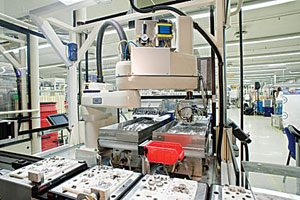“True flexible feeding means being able to solve tomorrow’s challenges today,” says Ruediger Winter, director of European sales at Adept. “Changing products no longer requires any hardware changes, but just a few minutes to teach the system to accept the new parts. This makes our customers feel safer about the long-term competitiveness of their assembly lines.”

|
|
A vision-guided SCARA robot retrieves parts from a flexible feeder at the Philips shaver assembly plant in Drachten, Netherlands. Photo courtesy Adept Technology Inc.
|
The shavers are assembled at Philips’ factory in Drachten, Netherlands, which is also home to the company’s research and development center. The shavers had to be produced at the highest level of quality, which is why the Drachten plant wanted to assemble them automatically rather than manually.
“The real challenge in finding the right solution for Philips was to accommodate the enormous model variety of the shavers,” says Matthias Schaller, head of robotics at BWM. Philips currently markets 60 different shaver lines, each with their own model variants. All totaled, Philips produces some 600 shaver models. As a result, the production mix at the plant changes almost daily.
Beyond that obstacle, Philips also wanted a system that would still be viable well into the future. “We wanted to implement a future-oriented assembly concept,” says Sietze Bremer, senior industrial sourcing specialist at Philips. “With regard to the total investment, we wanted to feel certain that the equipment would still be able to economically produce shavers in ten years without knowing what future shavers would look like.”
Building machinery capable of assembling products that don’t yet exist presented a significant challenge. BWM’s engineers chose Adept after realizing that they would need six-axis robots, SCARA robots, vision systems, parts feeders and controls. Adept’s technology met all requirements and had already shown its efficiency in similar projects for BWM.
The first item to address was how to maximize flexibility. The shaver consists of three main components that can be assembled independent of one another on different lines. Thus, the assembly system itself was also modular.
The three-head shavers are assembled on nine lines, each composed of five to eight cells. Each cell operates autonomously and can be connected or disconnected in plug-and-play fashion. Small, mutually independent lines with autonomous cells maximize the system’s flexibility and availability.
All totaled, the line contains more than 120 robots and 40 flex feeders. “The majority of Viper six-axis and Cobra SCARA robots are equipped with AdeptSight vision guidance and inspection technology,” says Bremer. “The systems arrive already having been tried and tested in existing lines. The robots impress with their precision, speed and availability.”
Adept’s AnyFeeder flexible feeders are a critical component of the system. The feeder works like this: A bulk hopper dumps a small amount of parts onto a tray. The tray gives the parts a quick shake to randomly distribute them across its surface. A vision system above the tray locates and inspects the parts and directs a robot to retrieve any that are correctly oriented for pick up. When all the parts have been picked up, the process repeats. Changeover is simply a matter of pouring in new parts and changing the vision program. The surface of the tray is easily changed to optimize the performance of the vision system or accommodate a sensitive part.
“Flexible feeding systems are key components for intelligent assembly automation, especially relating to the sustainability of the Philips equipment,” says Schaller. “Regardless of how the individual parts of the shaver will look in the future, the AnyFeeder will feed them as bulk goods. After ‘seeing’ the parts, the robots will pick them up and assemble them. In ten years, this simple and basic principle will not change.”
Vision guidance has been added to approximately 50 robots on the new assembly lines. Most of the robots on the existing lines were already equipped with vision guidance, and all new machines are required to have a vision system. “A robot with integrated vision guidance can be perfectly adopted for varying tasks,” says Bremer.
For more information robots and flexible feeders, call 800-222-1117, visit www.adept.com or e-mail info@adept.com.
For more information on automated assembly systems, visit www.bwm-gmbh.de or e-mail bwm@bwm-gmbh.de.
Editor’s note: Whether you’re a systems integrator or the in-house automation team of an OEM, if you’ve designed a system that you’re particularly proud of, tell us about it. Send an e-mail to John Sprovieri, chief editor of ASSEMBLY, at sprovierij@bnpmedia.com, or call 847-405-4068.

